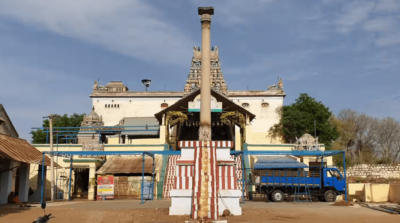Kurinji Andavar, Kodaikanal Murugan Temple
The Kurinji Andavar Murugan Temple, located in Kodaikanal, Tamil Nadu, is a prominent temple dedicated to Lord Murugan, also known as “Kurinji Andavar.” The name “Kurinji Andavar” translates to “God of the Kurinji flowers,” which are unique to the hilly regions of the Western Ghats. The temple not only serves as a religious site but also highlights the connection between Murugan worship and the natural landscape of Tamil Nadu, especially the hill areas.
Kurinji Andavar, Kodaikanal Murugan Temple History
Historical Background
- Founding: The Kurinji Andavar Murugan Temple was built in 1936 by a European woman named Lady Ramanathan, who was originally known as Alice Betty Nelson. She converted to Hinduism and took the name Meenakshi after marrying Ponnambalam Ramanathan, a prominent Tamil lawyer, politician, and philosopher from Sri Lanka. Her devotion to Lord Murugan led her to build this temple in Kodaikanal.
- Murugan Worship: The temple was established to promote the worship of Lord Murugan in the hill regions, following the tradition of associating Murugan with mountains and hills. In Tamil culture, Murugan is regarded as the “God of the Hills” and has a deep connection to the mountainous landscapes known as “Kurinji” in Tamil Sangam literature.
The Deity – Kurinji Andavar
- Lord Murugan as Kurinji Andavar: The main deity of the temple is Lord Murugan, who is worshipped here as “Kurinji Andavar.” The title refers to Murugan as the “God of the Kurinji land” (mountainous region), symbolizing his dominion over the hills and the Kurinji flowers that bloom once every 12 years in the area.
- Spiritual Beliefs: The temple is a place of pilgrimage for devotees who come to seek the blessings of Lord Murugan for protection, prosperity, and the fulfillment of wishes. The Kurinji Andavar form of Murugan is associated with youth, beauty, and the rejuvenating qualities of nature.
Festivals and Celebrations
- Thaipusam: One of the major festivals celebrated at the Kurinji Andavar Temple is Thaipusam, which falls in the Tamil month of Thai (January–February). Devotees participate in rituals such as carrying the “Kavadi” and performing various offerings to please Lord Murugan.
- Panguni Uthiram: Another significant festival, Panguni Uthiram, celebrated during the Tamil month of Panguni (March–April), marks the celestial wedding of Murugan and Deivanai. It is a time of grand festivities, attracting a large number of devotees to the temple.
- Kurinji Flower Blooming: When the rare Kurinji flowers bloom (approximately every 12 years), the temple becomes a center of cultural and spiritual activities, as these flowers hold a sacred place in Tamil literature and Murugan worship.
Architecture
- South Indian Style: The temple architecture follows the traditional South Indian style, with a modest structure that includes a sanctum sanctorum housing the main deity and a hall for devotees to gather for prayers.
- Simplicity and Natural Harmony: The design of the temple emphasizes simplicity and blends harmoniously with the surrounding natural landscape, making it a peaceful spot for meditation and worship.
Cultural and Literary Significance
The temple not only serves as a place of worship but also connects to the literary and cultural traditions of Tamil Nadu. The term “Kurinji” has significant importance in Tamil Sangam literature, where it refers to the landscapes associated with love and beauty, and Murugan is often portrayed as the presiding deity of this region.
The Kurinji Andavar Murugan Temple stands as a testament to the enduring devotion to Lord Murugan and the cultural heritage of the Tamil people, integrating spirituality with the natural beauty of Kodaikanal’s hills.
Location and Scenic Beauty
- Location: The temple is situated approximately 4 kilometers from the heart of Kodaikanal, a popular hill station in the Western Ghats of Tamil Nadu. It is perched at an elevation of around 2,000 meters (6,600 feet) above sea level, surrounded by lush greenery and rolling hills.
- Scenic Views: The temple’s hilltop location offers stunning views of the Palani Hills and the plains of the Vaigai Dam. It is a serene place where devotees and tourists can enjoy the tranquil environment and the scenic landscape.




